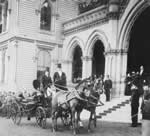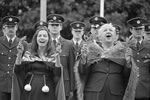Governor and Governor-General
The Governor-General (or the Governor before 1917) summons and dissolves Parliament, and assents to legislation it passes. The Governor-General also appoints the Prime Minister and attends the Executive Council to receive advice about government decisions. It is a convention that the Governor-General accepts the advice of a Prime Minister who is supported by a majority of the House.
Between 1840 and 1854 the Governor, appointed from Britain, ruled New Zealand on behalf of the Queen. The settlers had little time for rule by a Governor and wanted to elect their own government. After the elections in 1853, Governor George Grey angered the settlers by delaying the calling of Parliament. Grey's temporary successor, R.H. Wynyard, hardly helped when he refused to give power to a government formed from a majority in the House. This issue was not resolved until 1856.
After this, the House asserted itself, although the Governor kept an important role in military matters and Maori policies. Things reached a head in the 1860s, especially when the spiraling costs of the wars in the North Island got the country into financial trouble. In the end, New Zealand undertook to pay for its military affairs and the Governor's reserved powers over Maori affairs were removed. The Governor now became largely a symbolic figurehead.
Opening Parliament
The Governor-General plays an important part in the official or 'state' opening of Parliament. There have been changes over the years, and openings now generally occur only every three years (or after a general election). The basic format has remained largely unchanged since the first Parliament in 1854.
There is a 21-gun salute, guard of honour and trumpet fanfare to greet the arrival of the Governor-General outside Parliament. Since 1984, there has also been a significant Maori dimension, with a karanga (call for people to enter the area), a haka (ritual challenge) and a powhiri (formal welcome ceremony).
The state opening takes place in the Legislative Council Chamber, and is a colourful affair that involves considerable ceremony and some very old traditions. The Governor-General follows Black Rod into the chamber, and then Black Rod summons the MPs from the debating chamber of the House of Representatives. It is part of the Westminster tradition that the Governor-General, who represents the monarch, does not enter the House which is independent of the Crown. Black Rod knocks three times on the locked door of the debating chamber of the House, and then the MPs follow Black Rod, the Serjeant-at-Arms with the mace, and the Speaker to the Council Chamber. The Governor-General reads the Speech from the Throne, and as she or he leaves the buildings, there is usually singing and the National Anthem is played.
External link
Learn more: Governor-General's website.

